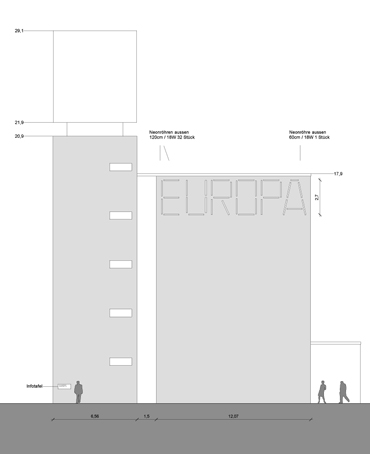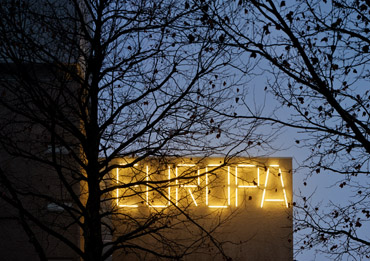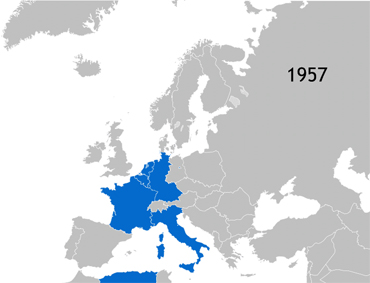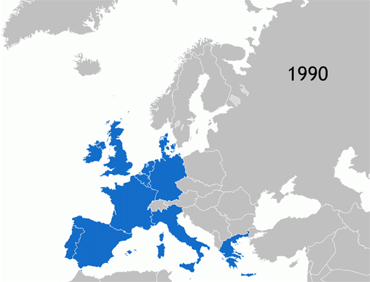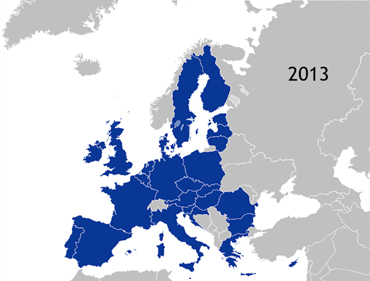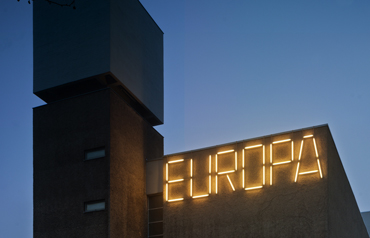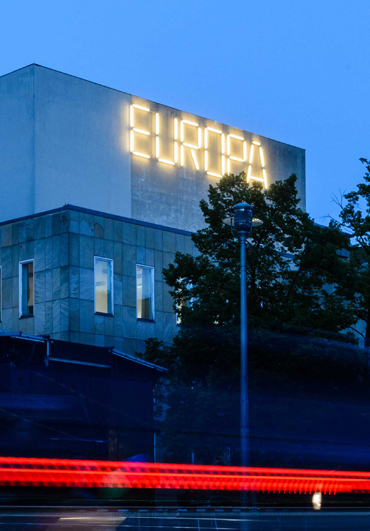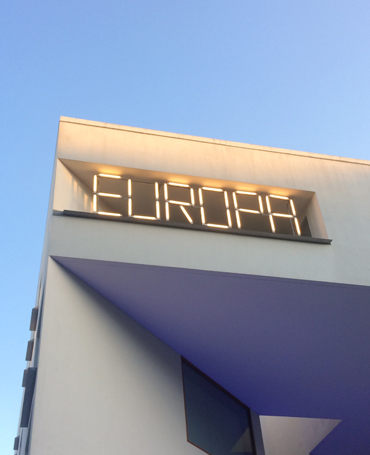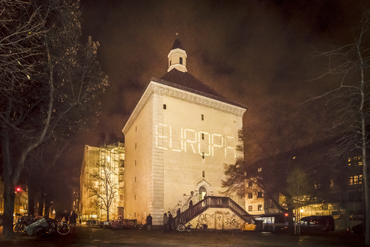morePlatz
architecture / urbanism / art / office / publications / contact deutsch
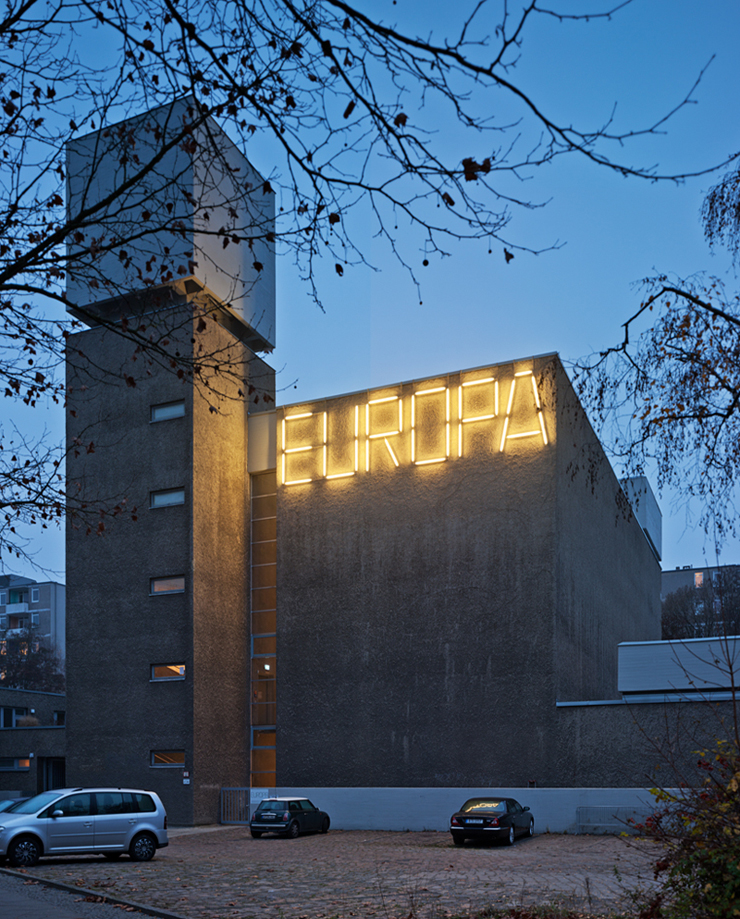
|
For a long time the European project was considered an obvious development that generated benefits for all parties concerned. The succession of serious crises that move the continent for a decade, endangers this project for the first time seriously. The Brexit could weaken the entire alliance sustainably. This is the background for a light installation on the facade of ST. AGNES in Kreuzberg, which opposes the lack of visibility and presence with a statement for Europe. The project of morePlatz installs the letters EUROPA of 33 fluorescent tubes on the eastern facade of ST. AGNES. The installation shone in autumn 2016 for half a year, and subsequently moved to other locations. The building of the former church is ST. AGNES with its bold appearance is part of the installation, quasi as a witness and support the idea of Europe. The building was renewed in 2015 and is since then used as exhibition space by the KÖNIG GALERIE who supports the project. |
| The highly visible installation should act as a strong sign and statement in public space. EUROPA represents the shared values of the European Community, stands for a free society and peaceful coexistence, and therefore for all the common achievements that are often perceived only unconsciously or as a matter of course. Over the past centuries, the 'old' continent has undergone a development that has improved the lives of people. Democracy, human rights, legal and social state, liberty of movement - everything is based on a more or less continuous development, which previous generations have fought for and built up. |
|
|
|
One of the greatest achievements after the two world wars was the extinction of old enmities, territorial claims and geopolitical expansion of individual nations and of nationalism as an ideology. Germany as a former aggressor plays in this case a special role. Respecting mutual limits was the prerequisite for overcoming them. The continuous economic boom of the postwar decades allowed the stable period of growth and prosperity, the so called ‚Golden Generation', which lasted until the end of the century. The sequence of crises of the new millennium has put this trend to an end. Although these crises do not originate only in Europe, a growing number of the population makes the EU responsible and blames her, partly from a lack of understanding or knowledge of the context. The Europe-wide shift to the ‚right' is the result. This is a dangerous development. Populists profit from the mistaken belief that a retreat into national borders can solve the current problems. |
|
|
In the age of digitalization and global networks it is not possible, to turn back the clock. People who are unable or unwilling to see beyond their own situation must be taken their fear of ‚strangers'. Europe needs to play to its strength and become aware of its advantages again. Anyone who has lived a longer period in another continent as for example Asia or Africa, can recognize the similarities of Europeans better than their differences. The European identity is still underdeveloped. But it's exactly this identity, which can guarantee a future for the European Union. This would require the improvement of living conditions for people who use Europe as a contiguous habitat, that exceed the national boundaries and that can recognize the larger context as a benefit. |
|
|
People who use the European freedom of movement for real and spend their CVs in different countries, need, for example, a European mobile telephone contract, a European health insurance, a European pension, a European bank and account number, a European car license plates, and a European Chamber of Commerce etc .. Some of these things are already being planned and are in any case easier to realize than a European citizenship, or a European tax system, not to mention a European Republic. The barriers that exist mainly due to the different languages, are evident and the complexity of the European project is tremendous. Once you say Europe, the background always reverberates with these complex relationships and manifold problems - but this sound also contains the whole history and the promise of a success. The installation 'EUROPE' as a statement is so simple, like a neon sign, such as advertising for a brand that needs no justification, that everyone wants to have. |
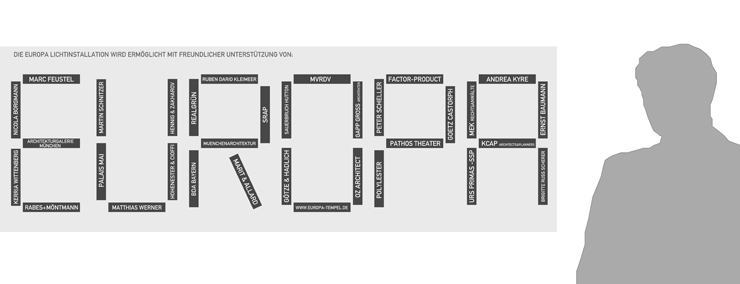
The opening of the installation took place on 26th of November at 6.00 P.M, Alexandrinenstr.118-121. Curator and writer Lukas Feireiss gave the opening speech. The project originates from the initiative of morePlatz and is realized in the fall of 2016. To achieve this, we organized the financing of the installation by ourselves. |
|
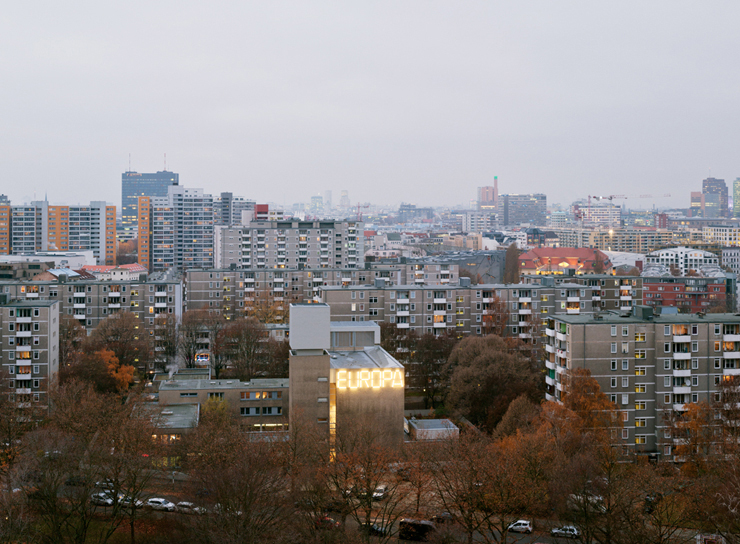
The installation at the ST. AGNES Church was temporary. Komische Oper Berlin Fotos © Ruben Dario Kleimeer, Jens Schlüter |
|
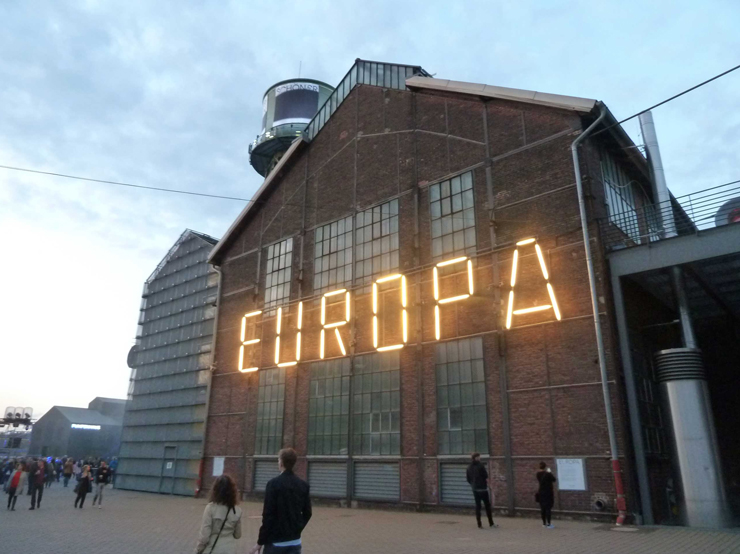
|
|
In Etsdorf, EUROPA is multipling for the first time. The sign will be installed permanently and glows automatically every evening for an hour. |
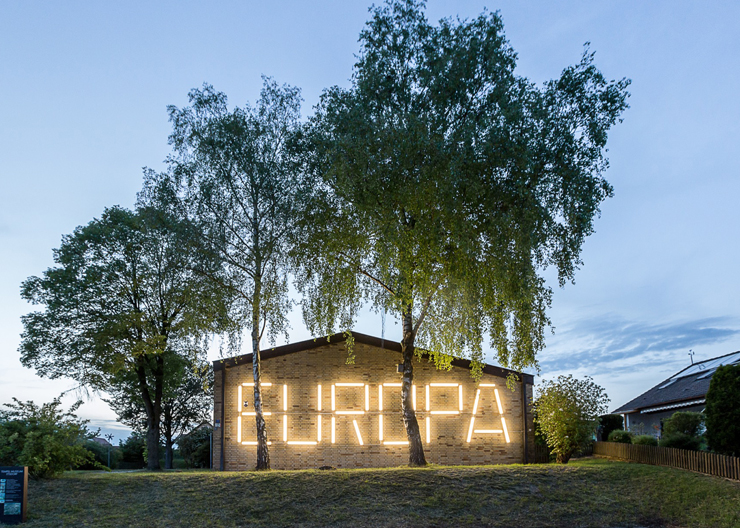
Since Friday 18th of May the EUROPE light installation is glowing on top of the mining tower next to Pact Zollverein in Essen. The UNESCO world heritage Zeche Zollverein offered a perfect location for the installation. Currently the former mixing plant is hosting the exhibition „Das Zeitalter der Kohle. Eine Europäische Geschichte“ where probalbly the most precious exhibit is the Original founding charter of the ‘European Coal and Steel Community’ on display. The so-called Montan Union paved the way to the European Union. Being part of the European cultural heritage year, the EUROPA light installation reached the roots of the European community and illuminated in the last year of coal production in North Rhine Westphalia historical aspects as well as future tasks for the European continent as climate change and renewable energies. |
|
The sign is glowing daily from 5 AM till midnight and is clearly visible from many viewpoints on the world heritage site. |
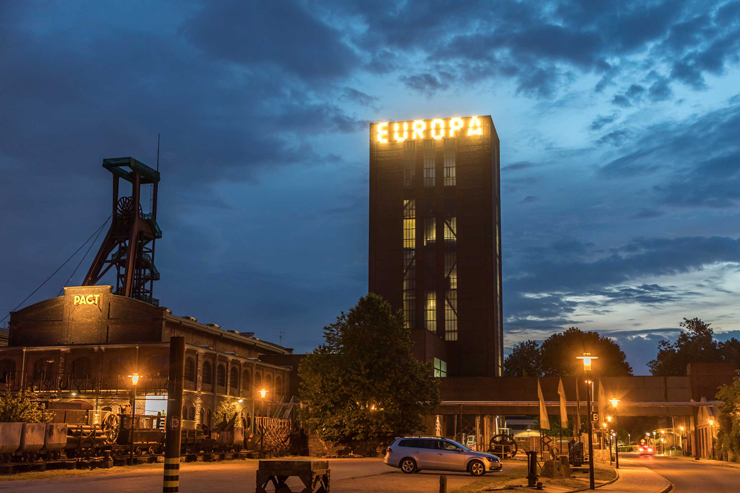
The light installation is shining for at least six months and refers to the application of Nürnberg as European cultural capital in 2025. The idea of mounting EUROPA at 'auf AEG' was initiated by Martin Schnitzer / Schnitzer&. Many thanks for the successful crowd funding and to all the new sponsors! |
|
sponsors: Michael Ziller / Zillerplus Architekten und Stadtplaner, Dionys Ottl / Hildundk, Markus Stenger / Stenger2 Architektur, Nicolette Baumeister, Markus, Nicole and Hannah Denzlinger, Andreas Grabow / Grabow Hofmann Architekten, Josef Grillmeier, Matthias Heyder / Rösttrommel Kaffeerösterei Nürnberg, Martin Hirner / Hirner Riehl Architekten, Achim and Vroni Kammerer / studio lot, Ingrid Krau, Silke Langenberg and Yves Ebnöther, Sven Lechner / nyx Architekten Ingenieure and Raumwerk 23, Gesellschaft für Bauprojektierung, Miguel Loos / Loos Architects, Robert Neuberger / Maier Neuberger Architekten, Katrin Rohr / luxophil lighting, Karin Schmid / 03 Architekten, Rainer Viertlböck und Roland Wochnik. Video: Louis Dölker |
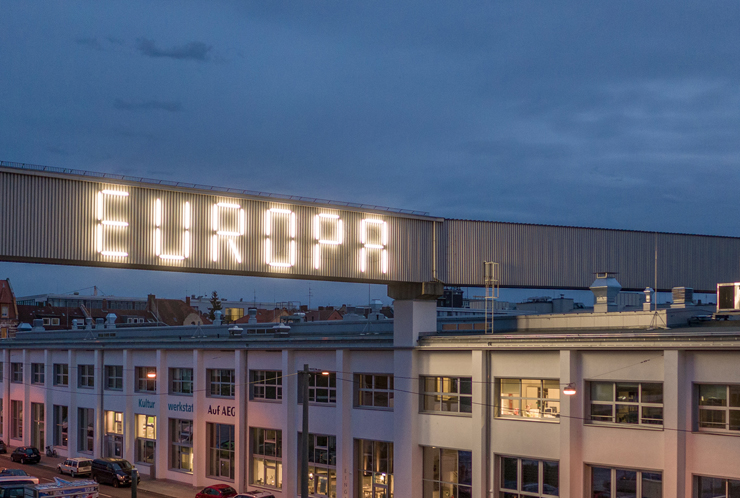
Under the motto "The space for city pioneers", the development in Hammerbrook promises a variety of perspectives. The landmark of the Bille power station has the potential to develop into an identificatory spot for the entire urban quarter. The EUROPA installation draws attention to the site as a work of art with far-reach and positively promotes this development. |
|
|

On the occasion of the Ruhrgames 2019, the Regionalverband Ruhr is implementing the EUROPA installation in the Landschaftspark Duisburg. |
|
The historical industrial atmosphere will be paired with EUROPA between the blast furnaces of the landscape park. |
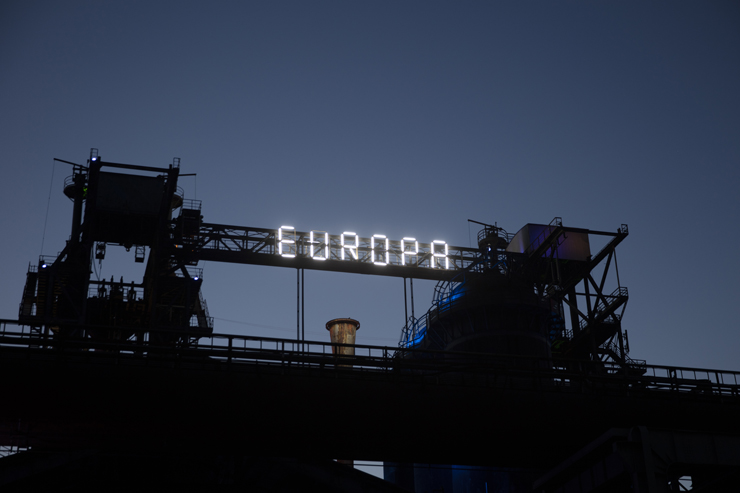
In 2019, the ‚Landesvertretung Baden-Württemberg' in Berlin was organizing its European theme year. On 27th of June, the traditional annual Party was held.
|
|
From the 27th of September to the 8th of October 2019 the days of industrial culture took place in Wirkbau. Dealing with industrial culture, as well as the tension between identity and change, is an exemplary topic in Chemnitz. |
|
the festival was kicked-off with the inauguration of the light installation EUROPA. We stand for Europe and make this visible in public space. |
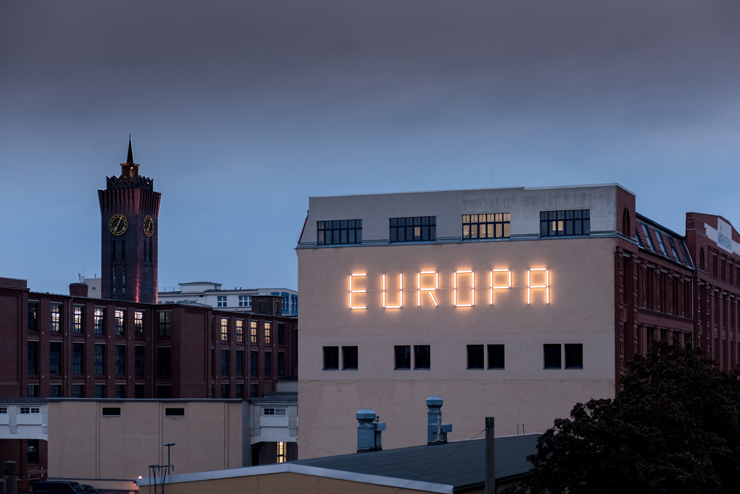
On the occasion of the 'Living the City' exhibition, the EUROPA light installation shone above the main entrance of Tempelhof Airport, on the former pedestal of the imperial eagle. Occupying this place with a shining symbol of tolerance, openness and solidarity in Europe had so far been the highlight of the project. |
|
A positive statement in public space for cohesion in Europe seems to have gained new relevance in 2020. With the European Green Deal, the continent is facing the challenge of restarting the economy after the corona crisis in a sustainable manner. |
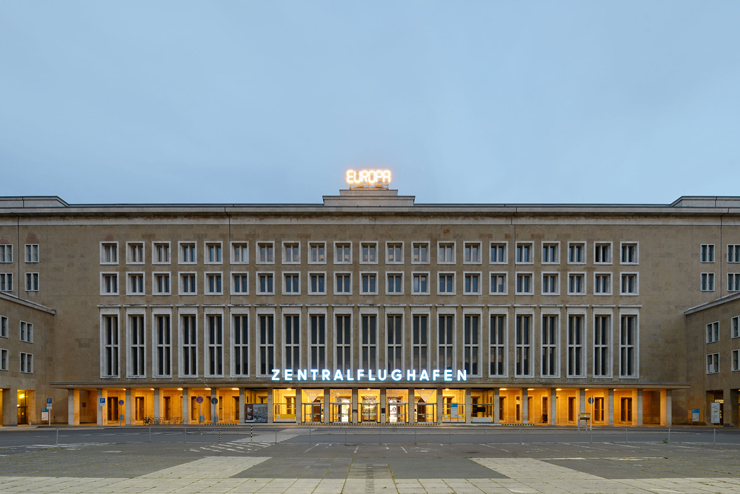
For the Munich Kunstareal Festival in mid-July 2021, the EUROPA light installation was installed on the building of the Faculty of Architecture on the 3rd floor in the windows facing Barerstraße. The installation is made possible by financial contributions from: Atakan Demirkiran - conmes, Bettina Elshorst, Dionys Ottl - Hild und K, Dorothee Maier - die meierei, Florian Sesser, Gerhard Gross, Guido Redlich, Hannes Dölker, Prof. Hansgeorg Bankel, Jan Foerster, Prof. Johannes Kappler, Josef Grillmeier, Katrin Rohr, Kerstin Anneser, Ursula Hartig – Make More DesignBuild, Martin Hirner, Prof. Martin Zoll, Petra Paulina Delfs, Petra Piloty, Robert Bloching, Prof. Sampo Widmann, Prof. Silke Langenberg, Prof .Thomas Neumann |
|
The Munich EUROPA light installation is supported by numerous institutions: |

|
|
In mid-November 2016, the project was presented in the bunker on Blumenstraße, the new location of the Munich Architecture Gallery. The opening date of the first light installation in Berlin on the 1st of Advent - as Advent lighting for St. Agnes - was already set. For the opening of the bunker, the lettering was projected onto the outside wall on November 10, 2016. On that evening the sponsors for the last fluorescent tubes of the first edition were found. Foto: Saskia Wehler
|
|
|
Both volumes are characterized by a vertical accent that stands out clearly from the main building - the nave on the one hand and here the hexagonal structure of the silos - and thus offers optimal visibility for the light installation. |

